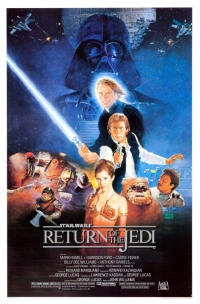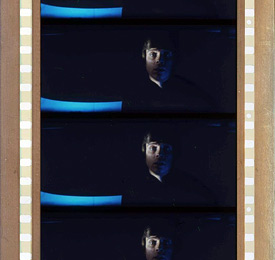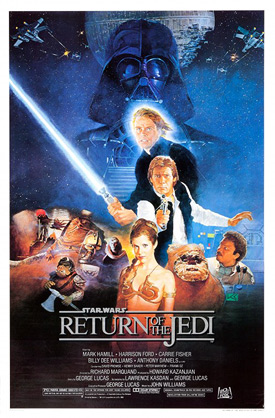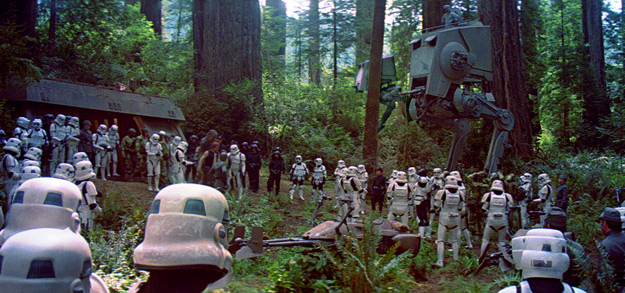
Coate: Was Richard Marquand a good choice to direct?
Kaminski: I think he was an appropriate choice given what George Lucas wanted, and that is an important distinction to remember. I don’t feel that he directed the film with the style and visual flair that Kershner brought, but I think Marquand did the best job anyone could. Lucas wanted the film done quickly and without great on-set cost, so the mandate was to film in quick set-ups, which is why the film has a rather flat and dull look to it, without much camera movement and intermixing between scene blocking and camera position, instead using simple, locked off angles without elaborate lighting so the film could be shot fast and then driven by editing. To be fair to Lucas, this is the exact same manner Star Wars and Raiders of the Lost Ark were made in, so there was fantastic precedent; Empire Strikes Back looks great because the film went so far over budget and schedule, and Jedi had a budget of about $30 million as it was, making it one of the most expensive films of its time even if everything went according to plan.
You also have to consider the script Marquand was working with, and if Jedi invites some criticism in story, character or dialogue, these are outside of his influence. His main area of influence — the performances — are as good as they can be with the script he had, and when the script is really good Marquand really delivers, as in the case of the scenes with Luke and Vader. The live-action scenes are directed competently, and if the cinematography looks like a made-for-television movie the visuals are made up for by ILM’s magic.
I think Marquand gets a bit short-changed because his life was tragically cut short and so his presence in the history of the series is often overlooked.
O’Connell: George Lucas hankered after Steven Spielberg to direct Return of the Jedi. Could you imagine a Spielberg Star Wars movie?! Sadly, Directors Guild stipulations and politics stopped that from ever happening and the Welsh Richard Marquand ended up taking on the baton from Irvin Kershner. Marquand was a British TV director whose 1981 thriller Eye of the Needle got the attentions of Lucasfilm and its producers.
Sadly, his canon of movie work was short-lived as Marquand prematurely passed away in 1987. It is safe to say what he gave the film was a sense of control. It was probably no easy task to take on the mantle after A New Hope and The Empire Strikes Back. Alongside the challenges of fan expectation, Marquand not only came into a unit made up of a cast and crew who were suddenly getting a new teacher in year three, he had to no doubt contend with the demands of a sci-fi opera of this nature. Yet — even with those conditions and the understandable twitching of franchise flame holder George Lucas — Marquand created a movie that holds together admirably. After the wilfully enclosed and sparse environs and emotions of Empire, Marquand opens out Return of the Jedi with a big scale intent. As soon as we start we are on an expansive and renovated Death Star, the droids are lone figures again in a sea of sand and the full might of the Empire and Rebellion are finally laid bare. Yes, Han Solo’s role could be more influential, and Leia loses that sense of fight from before. Yet, Marquand successfully spins all the requisite plates — and ends up with a fully-fledged intergalactic war movie those yellow crawls had been promising since May 1977. It keeps its soul, humor, and warmth in its sights at all times — despite multiple narratives all vying for attention and their big conclusions. Marquand is responsible for that. The fact that Lucas never allowed another director to take on an episode on his watch may speak certain volumes, but that may not be solely down to Richard Marquand himself.
Stevens: A lot has been written about George Lucas steering clear of using directors from the Directors Guild of America, so he had to choose from a fairly short list of capable candidates. In any case a Star Wars movie is so tightly scripted and storyboarded that it hardly requires any direction, unless in the mode of Irvin Kershner, the person at the helm decides to improve the material they’ve been provided with. Richard Marquand stuck to the script (which was perhaps unavoidable with Lucas over his shoulder) but he put his stamp on the film nonetheless. In the pre-production planning Marquand fine-tuned the script with George Lucas and Lawrence Kasdan. Marquand was also attentive to the acting. There was an incident where Carrie Fisher was standing in her Boushh costume like a soldier on parade but Marquand told her to be stealthier. It could be argued that Marquand could have drawn out better performances, especially from Harrison Ford but if an actor is uncommitted there must be only so much a director can do. Lucas himself was present at much of the filming and is not known for his communication with the cast. Overall I think that Richard Marquand did an excellent job and perhaps elevated the film by some degree from the pulp that was in the script.
Coate: Where do you think Jedi ranks among the original trilogy of films? Among the entire saga?
Kaminski: On a personal level, I consider it easily the most flawed of the original three, but it continues the story of Empire Strikes Back and has characters I already love — because of this, it rides on the coattails of Empire and overcomes flaws that would otherwise seriously harm the film. I always have a hard time placing those good-but-not-quite-great Star Wars films like Revenge of the Sith, Return of the Jedi, Force Awakens or Rogue One and Last Jedi. To me, there are only two great Star Wars films — the original and Empire Strikes Back — and then everything sort of falls in the middle, with Phantom Menace and Attack of the Clones way down at the bottom. I think Return of the Jedi is armed with a secret weapon that none of the other films have though, in that despite having flaws like most of the other films, it gets lumped into the pantheon of Star Wars and Empire by virtue of being the conclusion to the characters and narrative of those films, whereas something like Revenge of the Sith has the opposite problem and has to fight against its ties to two films that failed to develop compelling plot and characters. If J.J. Abrams doesn’t drop the ball with Episode IX I think the new trilogy could stand up fairly well, but nothing will ever come close to that first trilogy, because, well, it’s the first. It did everything for the first time. And as I mentioned — for all its flaws, there is no Star Wars trilogy without Return of the Jedi.
O’Connell: It is a hard trilogy to emerge as victor when you have A New Hope and The Empire Strikes Back in your group too. The original trilogy especially are all very different movies with unique parameters and story needs. Return of the Jedi is a masterclass in movie production, effects, modeling, editing and design. Revenge of the Sith, Rogue One and no doubt Episode IX all echo the adventure and genre achievements of Star Wars ’83. And in a movie era of comic book franchises that don’t know how to conclude as separate, standalone movies or even sagas, Return of the Jedi is an ever valuable blueprint in how to conclude with a swagger, confidence and narrative urgency. One observation about the film is how confident it is with its scope, story requirements and audience expectations. One could observe that no Star Wars film since has been so successful with its three act intent and ability to juggle its disparate story elements.
Stevens: To my mind Return of the Jedi is on balance, on a par with its forbears in the trilogy. Each film delivers its own unique package. It’s a common view that the third chapter of the original trilogy is the weakest but now that everyone knows the outcome of the film, only the first time viewer of Return of the Jedi can be kept in suspense. Even then, it is unlikely for people not to know that Darth Vader is Luke’s father, that the Death Star was destroyed and the rebels won (sorry if that’s a plot spoiler for anyone).
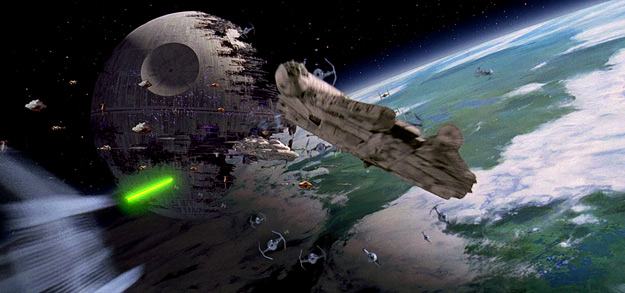
Coate: Do you have a preference for the Original or Special Edition? In what way was the Special Edition special?
Kaminski: The Special Edition of the film as it currently stands (2011 Blu-ray) is unwatchable to me because of the ending of the film, more so than Han shooting second which I have an easier time overlooking. I don’t complain much about my favorite franchise being “ruined” like you see so many fans these days, who either are new to their fandoms themselves or have very short memories, but the ending of the film — the ending of the trilogy, when the full meaning of the saga comes to crystallization — has been muddled with changes that completely take one out of the experience, as Darth Vader shouting “Noooo” in a reprisal of a dramatic deflation from Episode III notorious for being unintentionally comedic, and the appearance of Hayden Christensen in place of the redeemed Sebastian Shaw that we saw unmasked a few minutes prior, which makes no sense at all and undermines the arc of Anakin’s character. But I could take the 1997 version, which has some okay additions, especially in the expanded ending which makes better sense in the context of the larger series of today (the 1997 version also lacks the Jar Jar inclusion of 2004’s revision). The new Jedi Rocks dance musical is distractingly bad, but I always thought Lapti Nek was pretty embarrassing too. I honestly do believe Lucas was intentionally trolling the fans with his late addition of Darth Vader shouting “Noooo” in 2011, knowing that it had already become a meme making fun of his writing and directing in Revenge of the Sith. Lucas sometimes holds grudges with a mischievous sense of humor, as when he was photographed on the set of Indiana Jones and the Kingdom of the Crystal Skull a couple years earlier wearing a “Han Shot First” t-shirt.
O’Connell: I am not someone who automatically neck-chokes the Special Editions to the floor. It is sometimes overlooked how George Lucas’s insistence on updating and improving the original trilogy is why we have Star Wars movies today. Some fans may not have liked the new additions and quirks, but they spurred on new audiences to engage with the movies at home and at the movies. The 1997 Special Editions particularly proved the box office love for these films. Imagine if Lucas and Lucasfilm hadn’t renovated the original trilogy at all (which was something he was doing from the first week of release of A New Hope — for reasons of getting it right, not tampering). I am not so sure younger audiences today would fall in love with the original trilogy in its original form had Lucas not upgraded the visuals, sounds and effects to progress and evolve with the times and to feel and operate like non-Eighties movies.
But yes — the originals are the best! The new flourishes of Return of the Jedi — the Palace aliens breaking the fourth wall, the new Max Rebo Band number, the tulip-tentacled Sarlaac Pit, the new Ewok celebration tune and even the non-Star Wars-y explosive ripples of the Death Star’s destruction — do not add anything that was not there to begin with. But they justified new cinema releases which in turn led to new cinema audiences, new fans, new product, and new trilogies.
Stevens: Personally speaking I don’t consider the Special Edition to be all that special. There wasn’t anything in the film that needed fixing. Two of the changes are simply abysmal; the song and dance routine in Jabba’s Palace and the addition of Hayden Christensen’s ghost at the finale (not to mention changing the closing theme and scenes of celebration around the galaxy). I never watch the Special Edition at home.
Coate: What is the legacy of Return of the Jedi?
Kaminski: I think you have to put Return of the Jedi in the context of when it was made and what it was intended to do. It wasn’t the crowing epic of the six-chapter saga of Anakin Skywalker, it was meant to be the closing sequel to Star Wars that wrapped up the story and character arcs begun in that film in a story that was befitting the spirit of Star Wars. The first act at Jabba’s Palace and the corny original closing of “Yub Nub” strike younger viewers as out of place, but I think those two elements are the best examples that illustrate the original context of Return of the Jedi. The Jabba’s Palace sequence lets us see all our heroes together again making wisecracks with each other in a fun and exciting sequence after they were split up for most of Empire Strikes Back, while also celebrating the return of fan-favorite Han Solo, and Yub Nub is a fun and funny send off to our friends as the series ends with a chorus literally singing “celebrate the love” as our heroes clap around a camp fire. As the conclusion to the lighthearted and funny original Star Wars, it balanced the serious melodrama of Empire against that helluvvatime-at-the-movies sense of glee the original film had. George Lucas has said that he wanted audiences leaving the theater in 1983 to feel totally uplifted and in high spirits and in the mood to celebrate, just as the state we leave the characters, and I think that aspect has been lost now that the scale and scope of the Star Wars saga has outgrown that trio of films. You have Chewie and Han dancing with Ewoks and playing the drums on the helmets of stormtroopers, and then the film takes a quiet moment as the spirit of Anakin, Yoda and Obi-Wan appear to give Luke a thumbs up before he rejoins his friends and the music crescendos with “celebrate the love.” I think the original theatrical ending perfectly encapsulates how to appreciate the purpose and expectation in which the film was made, because it doesn’t exist in that context any more. It also has to be seen as a reaction against the departure of style and content that Empire brought, which is partly why it recycles so much.
O’Connell: The last act of Rogue One, the underworld gangsters of Solo, the production golds and reds of The Last Jedi, that the prequels were as much a Palpatine backstory as an Anakin Skywalker one, and that franchise mainstay of good people improvising as best they can with what they can to defeat evil. Add to that — the warm memories of Star Wars younglings who endlessly recreated those Jabba’s Palace scenes, the Speeder Bike chases around the school yard and the Sarlaac Pit which saw many a bedsheet rolled into a deadly tentacle and thrown down the stairs. It was a glorious entry point for those sky kids who missed the theatrical runs of A New Hope and The Empire Strikes Back. In a year of threes — Jaws 3-D, Amityville 3-D, Superman III, Smokey and the Bandit 3 — for one generation Return of the Jedi represents their beginning of Star Wars fandom, not the end of it.
Stevens: With its dramatic and satisfying conclusion of the overall plot and its upbeat finale, Return of the Jedi set the future of the Star Wars brand on an extremely sure footing and ensured that the trilogy would be regarded as one of the greatest of all time. That would not have transpired if the third chapter had been lackluster and had left audiences unmoved. The law of diminishing returns usually applies to film series but this is not the case with Return of the Jedi, judging by the audience reaction and box office takings in comparison to Empire. In the formative years of “blockbuster” films Return of the Jedi proved the viability of film series and the success of the Star Wars trilogy is something that film makers have strived to emulate ever since.
Coate: Thank you — Michael, Mark, and Craig — for sharing your thoughts about Return of the Jedi on the occasion of its 35th anniversary.
--END--
IMAGES
Selected images copyright/courtesy Lucasfilm Ltd., 20th Century Fox Film Corporation, 20th Century Fox Home Entertainment, The Walt Disney Company.
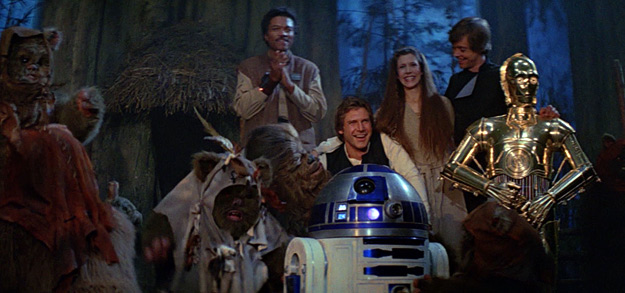
SOURCES/REFERENCES
The primary references for this project were regional newspaper coverage and trade reports published in Billboard, Boxoffice, The Hollywood Reporter and Variety. All figures and data included in this article pertain to the United States and Canada except where stated otherwise. This work is based upon articles by same author previously published at TheDigitalBits.com, FromScriptToDVD.com, In70mm.com and CinemaTreasures.org.

SPECIAL THANKS
Don Beelik, Raymond Caple, Andrew Crews, Sheldon Hall, John Hazelton, Bobby Henderson, Michael Kaminski, Bill Kretzel, Mark Lensenmayer, Monty Marin, W.R. Miller, Mark O’Connell, Jim Perry, Cliff Stephenson, Craig Stevens, and an extra special thank-you to all of the librarians who helped with this project.
IN MEMORIAM
- Graham Freeborn (Chief Make-up Artist), 1943-1986
- Richard Marquand (Director), 1937-1987
- Douglas Twiddy (Production Supervisor), 1919-1990
- Sebastian Shaw (Anakin Skywalker), 1905-1994
- Jack Purvis (“Teebo”), 1937-1997
- Alec Guinness (“Ben ‘Obi-Wan’ Kenobi”), 1914-2000
- Claire Davenport (“Fat Dancer”), 1933-2002
- Peter Diamond (Stunt Arranger), 1929-2004
- Mary Selway (Casting), 1936-2004
- David Tomblin (First Assistant Director/2nd Unit Director), 1930-2005
- James Glennon (Location Director of Photography), 1942-2006
- Alan Hume (Director of Photography), 1924-2010
- Fred Hole (Art Director), 1935-2011
- Ralph McQuarrie (Production Illustrator), 1929-2012
- Kay Freeborn (Make-up Artist), 19??-2012
- Stuart Freeborn (Make-up Designer), 1914-2013
- Kenny Baker (“R2-D2” and “Paploo”), 1934-2016
- Kit West (Mechanical Effects Supervisor), 1936-2016
- Carrie Fisher (“Princess Leia”), 1956-2016
-Michael Coate
Michael Coate can be reached via e-mail through this link. (You can also follow Michael on social media at these links: Twitter and Facebook)


